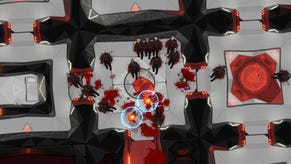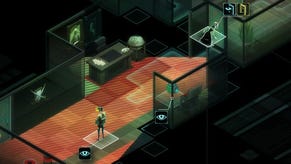Artful Dodging: Why Invisible, Inc.'s Rewind Button Is Great
If I Could Turn Back Time
Are you the kind of person who finds the stealthy route through every Deus Ex level, and who strives to ghost and no-kill every Dishonored level? Me too, but recently I've started to realise there's a cost to playing this way. A perfect ghost run requires just that: perfection. Being spotted is a blemish on my record that I just can't abide – so the second a guard sounds the alarm or raises their weapon, my finger is on the quick-load button, breaking the flow of my own experience and snapping the fiction of whatever game I'm playing.
But Invisible, Inc. [official site] does something miraculous. It solves that problem with a single button, because when my favourite agent finds themselves at the business end of a guard's semi-automatic with no chance of escape, there's always another option: rewind.
That might sound counter-intutive – the solution to habitual reloading is a reload button? When Klei introduced the Rewind feature in the game's sixth update, a good few months into Early Access, the community reaction was similarly bemused. I remember, because I was one of them.
Up until that point, the game had stuck pretty closely to the roguelike formula: procedurally-generated levels, randomised loot, and permadeath. The addition of rewinds looked like it might water down an compellingly tough game and, worse, rob those irreversible decisions of their impact.
But the key to rewinds' success is that they're limited. Three times per level, on the default difficulty mode, you can scrub the last turn-and-a-bit from the record and try something different.
This helps plaster over your small mistakes, including those caused by shortcomings on the game's part. The first time a fat-fingered button press sends an agent to their death, or a cluttered bit of UI has you confusing open space for cover, you'll be grateful it's there.
But better still, because the rewinds are a finite resource (at least, as long as you don't go fiddling in the mission settings) pressing that button itself becomes just another kind of irreversible decision. This isn't some neatly-placed quicksave that you can return as many times as you like. At Expert, the number of rewinds available drops to one and using it becomes an extension of the same system of risk/reward that underpins all your other tactical decisions.
Do you really want to use up your only rewind on a silly mistake you could still bounce back from? The game dangles the option of easy escape, but pushes you to hunt for any other available way out of the situation.
It's in these moments that Invisible, Inc. shines. As in any roguelike, it's perfectly satisfying to run around hoovering up loot and not dying, but it's only when stuff starts to goes wrong that the game becomes capable of setting fire to your brain. For example:
Jolie 'Banks' Murphy is sneaking past two heavily-armed Obake drones with the help of her newly-acquired cloaking device when it suddenly cuts out. Turns out she didn't read the label properly – it's only good for one turn's worth of invisibility. Both drones turn towards her, arm their weapons and click into overwatch mode. There are no hiding places left, and her supposed partner, the cyborg psychopath Adam Sharp, has already strolled into the level's exit teleporter and flipped the switch.
What do you do? You might:
a) Flip into Incognita mode and spend almost your entire stock of PWR to hack one of the drones and use it to take down the other so Banks can flee.
Oh, bugger. Turns out the bot you didn't hack is a 2.0 model, with armour plating that your puny robo-gun won't even dent. Rewind!
b) Empty your actual entire stock of PWR to hack the 2.0 drone, and commander its weapons.
Success. The smaller bot is torn to pieces... but the shots attract the attention of guards in the adjacent rooms, who next turn will come skidding through both doorways and immediately spot the exposed Banks, stood in the middle of an open-plan office. Rewind!
c) Give it a few minutes of serious, chin-stroking thought before a light comes on somewhere in the back of your brain: that EMP pack you've been carrying the whole game and never used!
The drones collapse to the floor without a sound. Banks sprints to the exit, flips the switch, and teleports back to base to give Sharp a black eye. You take a sip from the cup of tea that has been going cold next to the keyboard, celebrating a job well done, and thank Control you're playing at a difficult setting that has more than one rewind.
This is Invisible, Inc. at its absolute best, in which you're playing right on the knife-edge of failure before pulling it back. Escaping a level knowing you were just one step away from total failure, the alarms pushed as deep into the red as they'll go, one agent slumped unconscious in the teleporter and half a dozen guards advancing on your position as you flick the switch... That's magnificent.
When you manage to pull it off, there's an incredible sensation that you managed to pluck out the only possible solution from a haystack of failed attempts. Rewinding doesn't undermine that sensation, it reinforces it. It's not too dissimilar to the way Life is Strange's own rewind feature – as broken down in Marsh's recent Fail Forward video – actually improves on the Telltale format of big binary choices by letting you see both sides of the story.
Because Invisible Inc allows you to make a set of choices, see they're a dead end, then back up and turn a different corner instead, you get to see more ways you could've failed. It just makes your eventual solution – to a randomly-generated problem, remember, that only you have ever encountered – feel even more unique.
And when it doesn't come off, and you screw it all up a third time, only spotting the perfect solution as your final agent goes down for good? Well, that's just a good excuse to fire the game up all over again.
Invisible, Inc. is our Game of the Month for June, which means we think it's the one game you should play right now if you only have time to play one game. Read our Verdict for more on why.












